




The Japanese honours system is a system implemented for rewarding awards to Japanese and non-Japanese persons for their achievements and service to Japan. The Emperor is the head of the honors system in Japan.
Established during the 1870s shortly after the Meiji Restoration, it was modelled on European systems of orders and decorations. The first order, the Imperial Order of Meiji, was established in 1875, and was later renamed as the Order of the Rising Sun.[1]
Orders and decorations in Japan consist of the conferral of honours and awards, medals, and titles (the latter abolished in 1947), which were established during the Meiji period as a system for the state to recognise individuals' achievements.[2]
The Decoration Bureau of the Cabinet Office is responsible for administrative duties relating to the conferment of awards, research on the honours system, and planning.[3] The awarding of honours is one of the prescribed constitutional functions of the Emperor of Japan, with the advice of the Cabinet.[4]
Since 2003, the Government of Japan through the Decoration Bureau uses a recommendation system in members of the public can recommend candidates for the honours.[5]
|
Main article: Order of the Chrysanthemum |
Established in 1876, this is the premier order of Japan, originally in one class (Grand Cordon) and expanded to two classes (Collar; Grand Cordon) in 1888.[1]
|
Main article: Order of the Paulownia Flowers |
Established in 1888 as a Special Grand Cordon to the Order of the Rising Sun, it was later made a separate order in 2003. Ordinarily the highest regularly awarded honour, it is conferred in a single class (Grand Cordon); typically awarded to Japanese prime ministers, senior statesmen, select foreign heads of government, distinguished cabinet ministers and jurists. Until 1947, it was also awarded to distinguished military officers of the rank of General or higher, or its equivalents.[7]
|
Main article: Order of the Rising Sun |
The order was established in 1875 as Japan's first order.[8] Awarded in nine classes prior to 2003: The Grand Cordon of the order is typically awarded to foreign heads of government, chairpersons of prominent international organizations and leading politicians, business leaders and diplomats. The second class is typically conferred upon prominent academics, politicians and military officers. The third through sixth classes are ordinarily conferred upon individuals who have made significant contributions to Japan in varying degrees. The 7th and 8th classes of the Order were abolished in 2003, and the Special First Class of the Order was renamed the Order of the Paulownia Flowers.
|
Main article: Order of the Sacred Treasure |
This order was established in 1888 as the Imperial Order of Meiji in eight classes. Since the revision of the honours system in 2003, the Order of the Sacred Treasure has been awarded to civil servants for their long-term contributions. They include government and local officials, military personnel, scholars of national universities, and school teachers. For example, from 2014, the former Chief of Staff, Joint Staff is awarded Grand Cordon of the Order of the Sacred Treasure at the age of 70. The 7th and 8th classes were abolished in 2003.
|
Main article: Order of Culture |
Established in 1937, this is a single-class order of merit to honour those who have made outstanding contributions to Japanese culture. Japanese Nobel Laureates are awarded the Order of Culture.
|
Main article: Order of the Precious Crown |
Established in 1888 in five classes, the order expanded to seven classes in 1896. The 7th class of the order was abolished sometime after the Second World War. It was initially awarded to select foreigners who were not eligible for a higher honour but subsequently only awarded to women. From 2003, with the opening of the Order of the Rising Sun to Japanese women, the order has only been awarded to foreign females.
|
Main article: Medals of Honor (Japan) |
Established in 1881, the Medals of Honour honour individuals who have made distinguished achievements in their respective fields of society. The different medal categories can be seen below.[9]
The current types of Japanese orders, their classes and medals can be seen below.[10][11]
| Name (original name in Japanese above) and image | Remarks | |
|---|---|---|
| 大勲位菊花章 Supreme Order of the Chrysanthemum |
The highest order of merit in Japan | |
| 大勲位菊花章頸飾 Collar of the Supreme Order of the Chrysanthemum  | ||
| 大勲位菊花大綬章 Grand Cordon of the Supreme Order of the Chrysanthemum  | ||
| 桐花章 Order of the Paulownia Flowers |
The Grand Cordon of the Order of the Rising Sun or the Grand Cordon of the Order of the Sacred Treasure is awarded to persons who have distinguished themselves through their service or achievements. | |
| 桐花大綬章 Grand Cordon of the Order of the Paulownia Flowers  | ||
| 旭日章 Order of the Rising Sun |
Awarded to persons for their meritorious service to the state or the public | |
| 旭日大綬章 Grand Cordon of the Order of the Rising Sun 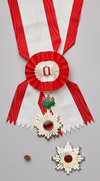 | ||
| 旭日重光章 Order of the Rising Sun, Gold and Silver Star  | ||
| 旭日中綬章 Order of the Rising Sun, Gold Rays with Neck Ribbon  | ||
| 旭日小綬章 Order of the Rising Sun, Gold Rays with Rosette  | ||
| 旭日双光章 Order of the Rising Sun, Gold and Silver Rays  | ||
| 旭日単光章 Order of the Rising Sun, Silver Rays  | ||
| 瑞宝章 Order of the Sacred Treasure |
Awarded to persons who have rendered years of meritorious service to the state or the public | |
| 瑞宝大綬章 Grand Cordon of the Order of the Sacred Treasure  | ||
| 瑞宝重光章 Order of the Sacred Treasure, Gold and Silver Star  | ||
| 瑞宝中綬章 Order of the Sacred Treasure, Gold Rays with Neck Ribbon  | ||
| 瑞宝小綬章 Order of the Sacred Treasure, Gold Rays with Rosette 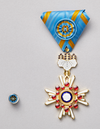 | ||
| 瑞宝双光章 Order of the Sacred Treasure, Gold and Silver Rays  | ||
| 瑞宝単光章 Order of the Sacred Treasure, Silver Rays  | ||
| 文化勲章 Order of Culture  |
Awarded to persons who have distinguished themselves in terms of cultural development. | |
| 宝冠章 Order of the Precious Crown |
Only women are eligible for the award. The award is given in special cases, such as ceremonial decorations for female members of the Imperial Family or foreign nationals. | |
| 宝冠大綬章 Grand Cordon of the Order of the Precious Crown 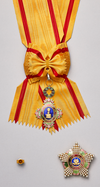 | ||
| 宝冠牡丹章 Order of the Precious Crown, Peony Class  | ||
| 宝冠白蝶章 Order of the Precious Crown, Butterfly Class  | ||
| 宝冠藤花章 Order of the Precious Crown, Wisteria Class  | ||
| 宝冠杏葉章 Order of the Precious Crown, Apricot Class  | ||
| 宝冠波光章 Order of the Precious Crown, Ripple Class  | ||
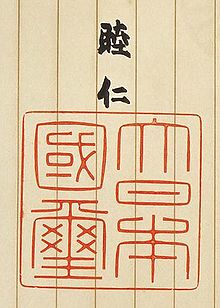
In addition to the decorations, the recipient to one of the orders is also awarded a decoration diploma. The diploma is a certificate bearing the name of the recipient, the name of the order awarded, the date of the award, the name of the awarding authority, etc., along with the State Seal of Japan. The text and content of the diploma according to the type of decoration. All the text in the diplomas is written vertically.
日本国天皇は ○ ○ ○ ○ に ○ ○ ○ ○ を授与する 皇居においてみずから名を署し 璽をおさせる 御名国璽 令和○年○月○日 内閣総理大臣○○○○印 内閣府賞勲局長○○○○印 第○○○○号
The Emperor of Japan will confer [name of the order]
to [name of recipient].
At the Imperial Palace, you will be asked to
sign and seal your name.
Imperial Seal
Reiwa YYYY MM DD
Prime Minister [name and personal seal]
Director-General, Cabinet Office Decoration Bureau [name and personal seal]
Number XXXX
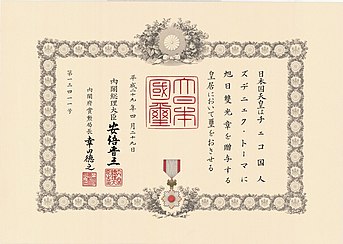
日本国天皇は○ ○ ○ ○に ○ ○ ○ ○ を授与する 皇居において璽をおさせる 国璽 令和○年○月○日 内閣総理大臣○○○○印 内閣府賞勲局長○○○○印 第○○○○号
The Emperor of Japan will confer [name of the order]
to [name of recipient].
At the Imperial Palace, you will be asked to
sign and seal your name.
State Seal
Reiwa YYYY MM DD
Prime Minister [name and personal seal]
Director-General, Cabinet Office Decoration Bureau [name and personal seal]
Number XXXX
In cases where signature of the Emperor and State Seal is affixed at a location other than the Tokyo Imperial Palace, e.g., Akasaka Palace, the diplomas will reflect the change and use "Akasaka Palace" instead.
The National Printing Bureau, an independent administrative agency of the Government of Japan, handles papermaking and printing of the diplomas for the decoration. In addition to the text, signature, Imperial Seal, and State Seal mentioned above, the design of the awarded order is imprinted on the medal. This model is printed using the decalcomania technique. In this technique, a skilled craftsman manually adds colours to the transfer paper one by one, which takes several days. In addition, a chrysanthemum crest is printed just above the centre of the medal. This chrysanthemum crest was also created by applying pure gold powder after gold under-printing, and then performing blank pressing (embossing).[12]
In order for Japanese nationals to be awarded, they must meet certain criteria specified by the Government of Japan.[13][14]
| Criteria for the conferral of orders | |
|---|---|
| Grand Cordon, Supreme Order of the Chrysanthemum | The highest conferred honour given for exceptional merit |
| Grand Cordon, Order of the Paulownia Flowers | For an exemplary and distinguished level of merit |
| Grand Cordon, Order of the Rising Sun | For highly distinguished national and/or public service |
| Grand Cordon, Order of the Sacred Treasure | For long and distinguished national and/or public service |
| Second - sixth classes, Order of the Rising Sun | For those cited for outstanding achievement |
| Second - sixth classes, Order of the Sacred Treasure | For long and distinguished public service |
| Order of Culture | For particularly significant achievements in regards to the furthering of cultural development |
| Criteria for the Medals of Honour | |
|---|---|
| Medal with Red Ribbon | Awarded to individuals who have risked their lives to save others |
| Medal with Green Ribbon | Awarded to morally remarkable individuals who have made voluntarily participated in saving society |
| Medal with Yellow Ribbon | Awarded to individuals who have become public role models |
| Medal with Purple RIbbon | Awarded to individuals who have contributed to academic and artistic developments, improvements and achievements. |
| Medal with Blue Ribbon | Awarded to individuals who have made efforts in areas of public interest and welfare |
| Medal with Dark Blue Ribbon | Awarded to individuals who have made generous financial contributions for the good of the public |
As of November 2021, a total of 150,632 orders have been conferred upon living Japanese nationals since 2003, when the honours system was overhauled. These include 19 awards of the Order of the Paulownia Flowers, 34,593 awards of the Order of the Rising Sun and 116,020 awards of the Order of the Sacred Treasure.[15][note 1] Of those decorations, the Order of the Sacred Treasure (77.02% of the total, all classes) is the most commonly conferred decoration, followed by the Order of the Rising Sun (22.97% of the total, all classes). The Order of the Paulownia Flowers is conferred the most rarely, at only 0.13% of the total number of decorations awarded since 2003.[15]
Per class of decoration, excluding the Order of the Chrysanthemum, the breakdown of decorations awarded by level since 2003 is as follows:
Since 2003, the most commonly conferred decorations by class and level in the top five categories as of 2021 have been:[15]
For the year 2021, 8,172 decorations were conferred in the following numbers upon living Japanese:[15]
In the system before the 2003 revision, titles consisted of two parts, the class number (kuntō) and the decoration. For example:
although their official English translations did not have these class numbers.[16] The 2003 revision removed the class part from the titles, thus: